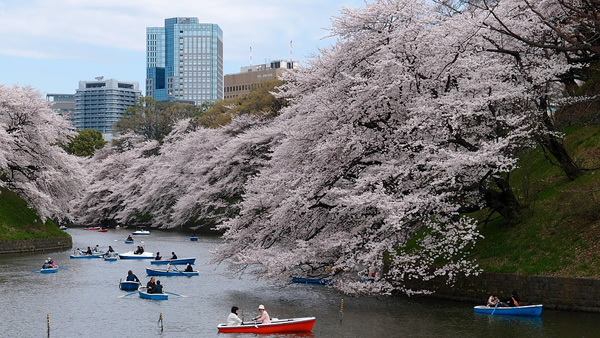Live, Learn and Teach English in Japan
By Christopher P. Cotter

|
|
Spring in a Tokyo park with the famous cherry blossoms.
|
A short vacation is not enough time to notice, let alone understand, the whys, hows, and what-fors that make Japan such a vibrant, changing culture. Luckily for the globetrotter, work here is easy to find and allows you enough free time to explore the country. You can even meet financial responsibilities back home with a decent pay package.
Teaching English at Private English Schools in Japan
English schools offer travelers the best opportunities to live and work in Japan. Most recruit year round, and almost all provide successful applicants with visa sponsorship, a subsidized apartment, at least partially-paid national insurance, and help with setting up bank accounts and the like. They also offer on-the-job training, frequent feedback sessions, and a set curriculum, which means you can soon conduct successful lessons without prior ESL experience. This also means that TEFL certification is not required, and may even be unofficially discouraged, as schools prefer to follow their own methods for classroom management and teaching. The most important qualification, apart from a sense of professionalism, is a genuine eagerness to live, learn, and teach in Japan.
Schools offer 25- to 30-hour weeks on average, although some set longer schedules. Teachers receive ¥250,000 to ¥300,000 ($2,300-$2,800) per month, depending on the school, its location, and the hours taught.
AEON has branches in the bright lights of Tokyo and the somewhat dimmer glow of smaller cities and offers roughly the same benefits. Teachers work in-house, as opposed to being out-sourced to businesses or public schools.
If the bureaucracy of corporate giants doesn't appeal to you Gaba is a smaller school with branches in Tokyo or other larger cities. Teachers are often allowed somewhat more freedom in the classroom; textbooks have not been specifically designed by the school for use with its teaching method.
Interac sends those who work for them to mostly to urban junior and senior high schools. This is ideal if you want total immersion in an all-Japanese work environment, although you may find yourself rotating between several schools. Interac recruits new applicants from overseas early in the year and in May and June. As positions open up during the school year, applications are also accepted year round if you are currently living in Japan. Westgate is a similar company that works with universities as well as elementary and secondary schools across Japan.
Teaching English With The JET Program
The Japan Exchange and Teaching Programme whose focus is broader than teaching English as a second language, is a government sponsored program. Foreign teachers live in and interact with local communities, primarily as English instructors in the classroom, and as offer as many creative opportunities as you can handle.
Most participants live in rural communities and work with an all-Japanese staff. Inevitably, bouts of culture shock arise from time to time. But the most significant difference is likely to be the students.
You are encouraged to work closely with students and the community, so the children's problems and individual needs can be addressed.
Participants earn ¥3,600,000 per year, or about $34,000 before taxes, health insurance, and pension payments. The work week is roughly 35 hours.
Part-Time Jobs Teaching English
In addition to English schools and the JET Program, there is an abundance of smaller schools, junior and senior high schools, and businesses looking for instructors. The requirements, benefits, and hours vary. Some positions require TEFL certification and past ESL experience. They offer visa sponsorship and a bonus, and are full-time. Other positions require no experience, are only open to current residents, and are for one or two evenings per week. Most work falls somewhere in between. Expect ¥2,500 to ¥3,000 yen per hour (USD$24-$28) for part-time, freelance work and a bit less for full-time.
GaijinPot is another website that lists full- and part-time ESL positions as well as non-ESL opportunities.
Jobs in Japan offers regularly updated, on-line jobs boards for full- and part-time ESL positions with smaller English and private schools.
Finally, if you are looking for casual work to pick up some extra travel money, take a look at GetStudents.net. This free service connects students and teachers for private classes. Simply fill out an online form with your contact details, availability, past experience, and qualifications, then wait for students to phone you for lessons.
Chris Cotter is an EFL teacher living in Tokyo, and juggles writing, teaching, and traveling. You can visit his website, Heads Up English, for language resources, articles and much more.
|
